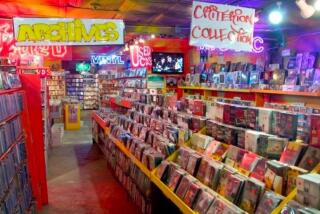VCRs Help Russians Be Video Pirates
MOSCOW â The Soviet pirate video market is one of the worldâs largest, with VCR ownership rising rapidly and copyright protection almost nonexistent.
Igor Maltsev, deputy editor of Dom Kino, a film industry magazine published by the Cinematographers Union, estimates that there could be as many as 1 million VCRs in Moscow alone--suggesting that on average, one out of every nine residents owns a unit. VCR ownership has spread widely in provincial Russia as well: Maltsev said that in a survey of the east Siberian region of Kamchatka, he counted about 25,000 units.
Currently, VCRs are occasionally available in Soviet commercial stores, with prices ranging from 6,000 to 10,000 rubles, or $3,300 to $5,500 at the commercial rate of exchange set by the government. Many Soviets obtain VCRs as bonuses through their companies or workplaces.
Maltsev said that whenever Soviet companies or government departments obtain hard currency to spend on their staff, VCRs are the priority purchase.
The high rate of Soviet VCR ownership, he said, âis a sign of a Third World country. We have such poor communications facilities, so the only way to learn about the outside world is to watch videos.â
As for distribution, Maltsev estimates that there are 270 outlets for rental, sales or showing of bootleg videos in Moscow alone, each earning from 8,000 to 15,000 rubles a month. These outlets are legally registered small businesses.
However, their numbers declined from about 400 outlets last year after the municipal government slapped a 70% profit tax on them.
While a sales or rental outlet might only sell four or five videocassettes a day, video salons, where films are screened, have a much higher turnover. One video salon manager, who would only give his name as Yura, said that the salon where he worked had five screenings a day, every day, with the clientele mainly made up of 20-year-olds and under.
At one ruble per ticket, the 80-seat salon earns 12,000 rubles a month. Of the 500 titles the salon maintains, the most popular are commercially oriented American films: âTango & Cash,â âTotal Recallâ and the âPolice Academyâ series.
Maltsev said that many of the outlets are supplied by an additional 1,500 free-lance video pirates who produce the bootleg tapes in their own homes with semi-professional equipment. The video copycats typically own four to 10 VCR units each, which are operated around the clock making recordings from master tapes.
The master tapes, in turn, are produced by another tier of operators: They purchase laser discs of popular films abroad and then record them onto master tapes with Russian-language dubbing. When the Soviet pirate video market was in its infancy, from about 1985-88, the dubbing business was dominated by two translators who have since become almost legendary in the annals of Soviet bootlegging.
They were known only by their pseudonyms: âVolodarski,â the son of a language professor at Moscow State University, who translated action films such as â48 HRS.â and âThe Last Starfighterâ and may have been responsible for dubbing one quarter of all bootleg U.S. videos before 1988, and âGerasimov,â a Jewish Soviet translator who specialized in comedies and animated films, such as âBeing There,â âYellow Submarineâ and âTop Cat.â
The bootleggers realize, for the most part, that their business is illegal. One video sales outlet clerk, who declined to give his name, recalled reading about the issue of copyright protection in the newspaper last year.
âThe Americans claimed that we should be paying for copyrights,â he said. âThey wanted to close all the video stores, but nothing came of it.â
More to Read
Sign up for Essential California
The most important California stories and recommendations in your inbox every morning.
You may occasionally receive promotional content from the Los Angeles Times.










